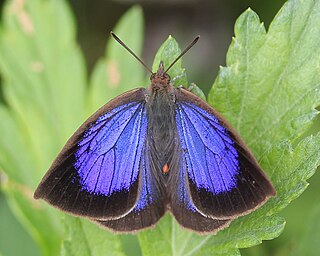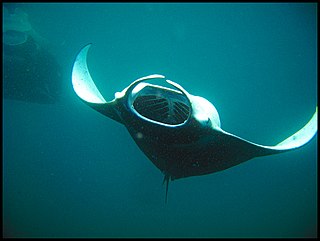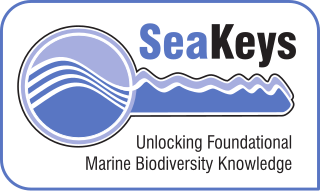Related Research Articles

Plankton are the diverse collection of organisms found in water that are unable to propel themselves against a current. The individual organisms constituting plankton are called plankters. In the ocean, they provide a crucial source of food to many small and large aquatic organisms, such as bivalves, fish and whales.

Zooplankton are heterotrophic plankton. Plankton are organisms drifting in oceans, seas, and bodies of fresh water. The word zooplankton is derived from the Greek zoon (ζῴον), meaning "animal", and planktos (πλαγκτός), meaning "wanderer" or "drifter". Individual zooplankton are usually microscopic, but some are larger and visible to the naked eye.

Ostracods, or ostracodes, are a class of the Crustacea, sometimes known as seed shrimp. Some 70,000 species have been identified, grouped into several orders. They are small crustaceans, typically around 1 mm (0.039 in) in size, but varying from 0.2 to 30 mm in the case of Gigantocypris. Their bodies are flattened from side to side and protected by a bivalve-like, chitinous or calcareous valve or "shell". The hinge of the two valves is in the upper (dorsal) region of the body. Ostracods are grouped together based on gross morphology. While early work indicated the group may not be monophyletic; and early molecular phylogeny was ambiguous on this front, recent combined analyses of molecular and morphological data found support for monophyly in analyses with broadest taxon sampling.
The mesopelagiczone, also known as the middle pelagic or twilight zone, is the part of the pelagic zone that lies between the photic epipelagic and the aphotic bathypelagic zones. It is defined by light, and begins at the depth where only 1% of incident light reaches and ends where there is no light; the depths of this zone are between approximately 200 to 1000 meters below the ocean surface.

Pandalus borealis is a species of caridean shrimp found in cold parts of the northern Atlantic and northern Pacific Oceans, although the latter population now often is regarded as a separate species, P. eous. The Food and Agriculture Organization refers to them as the northern prawn. Other common names include pink shrimp, deepwater prawn, deep-sea prawn, Nordic shrimp, great northern prawn, northern shrimp, coldwater prawn and Maine shrimp.

The Census of Marine Life was a 10-year, US $650 million scientific initiative, involving a global network of researchers in more than 80 nations, engaged to assess and explain the diversity, distribution, and abundance of life in the oceans. The world's first comprehensive Census of Marine Life — past, present, and future — was released in 2010 in London. Initially supported by funding from the Alfred P. Sloan Foundation, the project was successful in generating many times that initial investment in additional support and substantially increased the baselines of knowledge in often underexplored ocean realms, as well as engaging over 2,700 different researchers for the first time in a global collaborative community united in a common goal, and has been described as "one of the largest scientific collaborations ever conducted".

Arhopala is a very large genus of gossamer-winged butterflies (Lycaenidae). They are the type genus of the tribe Arhopalini. In the relatively wide circumscription used here, it contains over 200 species collectively known as oakblues. They occur from Japan throughout temperate to tropical Asia south and east of the Himalayas to Australia and the Solomon Islands of Melanesia. Like many of their relatives, their caterpillars are attended and protected by ants (myrmecophily). Sexual dichromatism is often prominent in adult oakblues.

Neuston, also known as pleuston, are organisms that live at the surface of the ocean or an estuary, or at the surface of a lake, river or pond. Neuston can live on top of the water surface or may be attached to the underside of the water surface. They may also exist in the surface microlayer that forms between the top side and the underside. Neuston have been defined as "organisms living at the air/water interface of freshwater, estuarine, and marine habitats or referring to the biota on or directly below the water’s surface layer."
The Census of Antarctic Marine Life (CAML) is a field project of the Census of Marine Life that researches the marine biodiversity of Antarctica, how it is affected by climate change, and how this change is altering the ecosystem of the Southern Ocean.
Global Census of Marine Life on Seamounts is a global scientific initiative, launched in 2005, that is designed to expand the knowledge base of marine life at seamounts. Seamounts are underwater mountains, not necessarily volcanic in origin, which often form subsurface archipelagoes and are found throughout the world's ocean basins, with almost half in the Pacific. There are estimated to be as many as 100,000 seamounts at least one kilometer in height, and more if lower rises are included. However, they have not been explored very much—in fact, only about half of one percent have been sampled—and almost every expedition to a seamount discovers new species and new information. There is evidence that seamounts can host concentrations of biologic diversity, each with its own unique local ecosystem; they seem to affect oceanic currents, resulting among other things in local concentration of plankton which in turn attracts species that graze on it, and indeed are probably a significant overall factor in biogeography of the oceans. They also may serve as way stations in the migration of whales and other pelagic species. Despite being poorly studied, they are heavily targeted by commercial fishing, including dredging. In addition they are of interest to potential seabed mining.

DNA barcoding is a method of species identification using a short section of DNA from a specific gene or genes. The premise of DNA barcoding is that, by comparison with a reference library of such DNA sections, an individual sequence can be used to uniquely identify an organism to species, in the same way that a supermarket scanner uses the familiar black stripes of the UPC barcode to identify an item in its stock against its reference database. These "barcodes" are sometimes used in an effort to identify unknown species, parts of an organism, or simply to catalog as many taxa as possible, or to compare with traditional taxonomy in an effort to determine species boundaries.
Jesse Huntley Ausubel is an American environmental scientist and program manager of a variety of global biodiversity and ecology research programs. Ausubel serves as Director and Senior Research Associate of the Program for the Human Environment of The Rockefeller University. He was also a science advisor (2011-2019) and program manager (1994-2011) at the Alfred P. Sloan Foundation where his main area of responsibility was supporting basic research in science and technology.

A planktivore is an aquatic organism that feeds on planktonic food, including zooplankton and phytoplankton. Planktivorous organisms encompass a range of some of the planet's smallest to largest multicellular animals in both the present day and in the past billion years; basking sharks and copepods are just two examples of giant and microscopic organisms that feed upon plankton. Planktivory can be an important mechanism of top-down control that contributes to trophic cascades in aquatic and marine systems. There is a tremendous diversity of feeding strategies and behaviors that planktivores utilize to capture prey. Some planktivores utilize tides and currents to migrate between estuaries and coastal waters; other aquatic planktivores reside in lakes or reservoirs where diverse assemblages of plankton are present, or migrate vertically in the water column searching for prey. Planktivore populations can impact the abundance and community composition of planktonic species through their predation pressure, and planktivore migrations facilitate nutrient transport between benthic and pelagic habitats.
Peter Robert Last is an Australian ichthyologist, curator of the Australian National Fish Collection and a senior principal research scientist at CSIRO Marine and Atmospheric Research (CMAR) in Hobart, Tasmania. He is an elasmobranch expert and has described many new species of shark.
Deborah K. Steinberg is an American Antarctic biological oceanographer who works on interdisciplinary oceanographic research programs. Steinberg's research focuses on the role that zooplankton play in marine food webs and the global carbon cycle, and how these small drifting animals are affected by changes in climate.

SeaKeys is a large collaborative marine biodiversity project funded through the Foundational Biodiversity Information Program in South Africa. The purpose of the project is to collect and distribute genetic, species and ecosystem information relating to marine biodiversity in southern Africa, which may be used to support informed decision-making about the marine environment.

DNA barcoding of algae is commonly used for species identification and phylogenetic studies. Algae form a phylogenetically heterogeneous group, meaning that the application of a single universal barcode/marker for species delimitation is unfeasible, thus different markers/barcodes are applied for this aim in different algal groups.

DNA barcoding methods for fish are used to identify groups of fish based on DNA sequences within selected regions of a genome. These methods can be used to study fish, as genetic material, in the form of environmental DNA (eDNA) or cells, is freely diffused in the water. This allows researchers to identify which species are present in a body of water by collecting a water sample, extracting DNA from the sample and isolating DNA sequences that are specific for the species of interest. Barcoding methods can also be used for biomonitoring and food safety validation, animal diet assessment, assessment of food webs and species distribution, and for detection of invasive species.

Compared to terrestrial environments, marine environments have biomass pyramids which are inverted at the base. In particular, the biomass of consumers is larger than the biomass of primary producers. This happens because the ocean's primary producers are tiny phytoplankton which grow and reproduce rapidly, so a small mass can have a fast rate of primary production. In contrast, many significant terrestrial primary producers, such as mature forests, grow and reproduce slowly, so a much larger mass is needed to achieve the same rate of primary production.
Ann Bucklin is a professor at the University of Connecticut known for her work using molecular tools to study zooplankton. Bucklin was elected a fellow of the American Association for the Advancement of Science in 1995.
References
- ↑ "Program Description at CoML Website". Archived from the original on 2012-06-21. Retrieved 2010-09-23.
- ↑ "An outstanding role model Ann Bucklin presented with Outstanding Achievement Award". www.ices.dk. September 9, 2019. Archived from the original on 2019-10-27. Retrieved 2021-09-25.
- ↑ Barcoding Scientific Paper
- ↑ "/CMarZ/ Data directory page".